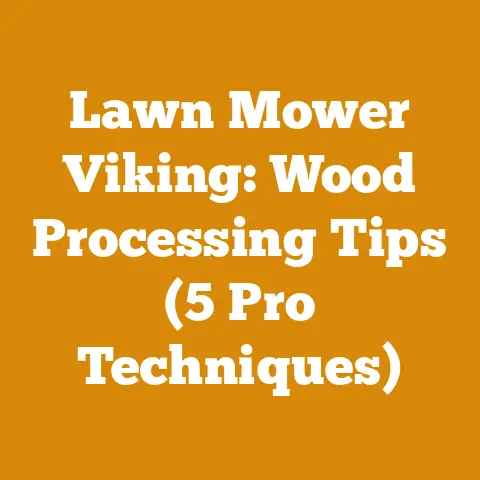How to Remove Evergreen Shrubs Near Foundation (Expert Wood Tips)
Let’s dive in!
As someone who has spent countless hours in the woods, felling trees, splitting logs, and generally making the most of what nature provides, I’ve come to appreciate the delicate balance between utilizing resources and preserving our environment.
Today, we’re tackling a common issue: removing evergreen shrubs near foundations.
This isn’t just about aesthetics; it’s about protecting your home and managing the wood responsibly.
Why start with eco-consciousness?
Because every decision we make in wood processing has an impact.
From the tools we use to the disposal methods we choose, sustainability should be at the forefront.
Removing evergreens, especially those close to your home’s foundation, requires careful planning and execution.
It’s not just about hacking away; it’s about understanding the implications for your property and the surrounding ecosystem.
I’ll guide you through the process, sharing my experiences and providing actionable tips that will help you get the job done efficiently and responsibly.
The Importance of Removing Evergreens Near Foundations
Evergreen shrubs, while beautiful, can pose several problems when planted too close to a building’s foundation.
Over time, their roots can infiltrate the foundation, causing cracks and structural damage.
The dense foliage can also trap moisture, leading to mold and mildew growth.
- Structural Damage: Roots can exert significant pressure on foundation walls.
- Moisture Retention: Dense shrubs prevent proper ventilation, promoting dampness.
- Pest Infestation: Shrubs provide shelter for insects and rodents.
- Reduced Sunlight: Blocking sunlight can affect the health of your home’s siding and nearby plants.
Project Planning: Assessing the Situation
Before you grab your chainsaw or loppers, take a moment to assess the situation.
Consider the size and age of the shrubs, their proximity to the foundation, and the type of soil you’re dealing with.
This initial assessment will inform your removal strategy and help you choose the right tools and techniques.
- Identify the Species: Knowing the type of evergreen shrub is crucial.
Some species have more aggressive root systems than others.
For instance, certain junipers or yews can be particularly invasive. - Measure the Distance: Note how close the shrubs are to the foundation.
If they’re touching the wall, the risk of damage is higher. - Inspect the Foundation: Look for any existing cracks or signs of moisture.
This will give you a baseline to compare against after the removal. - Check Local Regulations: Some areas have restrictions on tree and shrub removal, especially if they are mature or considered protected species.
Tool Selection: Choosing the Right Equipment
Having the right tools can make a world of difference.
Here’s a breakdown of essential equipment for removing evergreen shrubs:
- Hand Pruners: For small branches and delicate work.
- Loppers: For thicker branches that are beyond the reach of hand pruners.
- Pruning Saw: For branches up to 4-6 inches in diameter.
- Chainsaw: For larger shrubs and tree-like evergreens.
- Shovels and Pickaxes: For digging out the roots.
- Root Saw or Reciprocating Saw: For cutting through stubborn roots.
- Safety Gear: Gloves, eye protection, ear protection, and sturdy footwear are essential.
Chainsaw Selection and Maintenance:
For larger shrubs, a chainsaw is indispensable.
I’ve used various models over the years, and I’ve found that a lightweight, gas-powered chainsaw with a 14-16 inch bar is ideal for most shrub removal tasks.
Electric chainsaws are also a viable option, especially for smaller jobs or in areas with noise restrictions.
- Gas vs.
Electric: Gas chainsaws offer more power and portability, while electric chainsaws are quieter and require less maintenance. - Bar Length: Choose a bar length that is appropriate for the size of the shrubs you’re removing.
- Chain Sharpness: A sharp chain is crucial for efficient cutting and safety.
Learn how to sharpen your chain or take it to a professional. - Maintenance: Regularly clean and lubricate your chainsaw to ensure optimal performance and longevity.
Personal Story:
I remember one time, I was helping a friend remove some overgrown yews that were practically hugging his foundation.
We started with loppers and hand pruners, but quickly realized we needed something more powerful.
I brought over my trusty gas-powered chainsaw, and we were able to make quick work of the larger branches.
However, the real challenge was digging out the root balls.
We spent hours hacking away with shovels and pickaxes, but the roots were incredibly dense and stubborn.
Finally, we rented a root saw from a local tool rental shop, and it made all the difference.
It sliced through the roots like butter, and we were able to remove the shrubs in no time.
Removal Techniques: Step-by-Step Guide
Now that you have your tools and a plan, it’s time to get to work.
Here’s a step-by-step guide to removing evergreen shrubs near foundations:
- Prune the Shrub: Start by pruning the shrub to make it more manageable.
Remove any dead, damaged, or crossing branches. - Cut Back the Main Stems: Use loppers or a pruning saw to cut back the main stems to about 1-2 feet above the ground.
- Dig Around the Root Ball: Use a shovel to dig a circle around the root ball, about 1-2 feet away from the base of the shrub.
- Sever the Roots: Use a root saw or reciprocating saw to cut through any large roots that are anchoring the shrub.
- Lift the Root Ball: Once the roots are severed, try to lift the root ball out of the ground.
You may need to use a pry bar or a come-along to get it out. - Remove Remaining Roots: After removing the main root ball, dig around the area and remove any remaining roots.
- Fill the Hole: Fill the hole with topsoil and compact it to prevent settling.
Dealing with Stubborn Roots:
Sometimes, the roots of evergreen shrubs can be incredibly stubborn and difficult to remove.
Here are some tips for dealing with stubborn roots:
- Use a Root Saw: A root saw is specifically designed for cutting through roots.
It has a long, narrow blade with aggressive teeth that can slice through even the toughest roots. - Rent a Stump Grinder: For large shrubs with extensive root systems, renting a stump grinder may be necessary.
A stump grinder is a powerful machine that grinds the stump and roots into small chips. - Apply a Herbicide: If you’re unable to remove all of the roots, you can apply a herbicide to prevent them from resprouting.
Be sure to follow the instructions on the herbicide label carefully.
Wood Anatomy and Properties of Common Evergreens
Understanding the wood anatomy and properties of the evergreens you’re removing can help you determine the best way to utilize the wood.
Here’s a brief overview of some common evergreen species:
- Pine: Pine wood is relatively soft and easy to work with.
It’s often used for construction, furniture, and paper pulp.
Pine has a resinous odor and is generally straight-grained. - Spruce: Spruce wood is similar to pine but is slightly harder and more durable.
It’s commonly used for construction, musical instruments, and paper pulp.
Spruce is known for its excellent resonance properties. - Fir: Fir wood is soft and lightweight.
It’s often used for construction, plywood, and Christmas trees.
Fir has a mild odor and is easy to nail and screw. - Cedar: Cedar wood is highly aromatic and naturally resistant to decay and insects.
It’s often used for siding, fencing, and closets.
Cedar is also known for its beautiful color and grain patterns. - Juniper: Juniper wood is dense and durable.
It’s often used for carving, furniture, and fence posts.
Juniper has a distinctive aroma and is resistant to rot. - Yew: Yew wood is strong and flexible.
It’s often used for archery bows, furniture, and carving.
Yew is a slow-growing species and is highly valued for its unique properties.
Data Point:
According to the USDA Forest Service, the average density of pine wood is around 25-35 pounds per cubic foot, while the average density of cedar wood is around 20-25 pounds per cubic foot.
This difference in density affects the wood’s strength, durability, and suitability for different applications.
Utilizing the Wood: Sustainable Practices
Once you’ve removed the evergreen shrubs, don’t just throw the wood away!
There are many ways to utilize the wood sustainably:
- Firewood: Evergreen wood can be used as firewood, although it tends to burn quickly and produce a lot of smoke.
Be sure to season the wood properly before burning it. - Mulch: Evergreen wood can be chipped and used as mulch in your garden.
The mulch will help to suppress weeds and retain moisture in the soil. - Compost: Small branches and leaves can be added to your compost pile.
The compost will provide valuable nutrients for your plants. - Craft Projects: Evergreen wood can be used for various craft projects, such as carving, woodworking, and building birdhouses.
- Biochar: Evergreen wood can be converted into biochar, a charcoal-like substance that can be used as a soil amendment.
Biochar improves soil fertility, water retention, and carbon sequestration.
Firewood Seasoning Techniques and Safety Considerations:
If you plan to use the evergreen wood as firewood, it’s essential to season it properly.
Seasoning involves drying the wood to reduce its moisture content, which makes it burn more efficiently and reduces smoke production.
- Split the Wood: Splitting the wood increases its surface area, allowing it to dry more quickly.
- Stack the Wood: Stack the wood in a single row, with gaps between the pieces for air circulation.
- Elevate the Wood: Elevate the wood off the ground to prevent moisture from wicking up into it.
- Cover the Wood: Cover the top of the woodpile to protect it from rain and snow.
- Allow Time to Season: Allow the wood to season for at least 6-12 months, depending on the species and climate.
Safety Considerations:
- Wear Safety Gear: Always wear gloves, eye protection, and ear protection when handling firewood.
- Use a Safe Splitting Technique: Use a splitting maul or hydraulic splitter to split the wood safely.
- Store Firewood Away from Your Home: Store firewood at least 30 feet away from your home to reduce the risk of fire.
- Check for Insects: Check firewood for insects before bringing it indoors to prevent infestations.
Data Point:
According to the EPA, properly seasoned firewood should have a moisture content of less than 20%.
Burning unseasoned firewood can release up to 50% more pollutants into the air.
Unique Insight:
I’ve found that adding a layer of wood ash to the base of my firewood stack helps to absorb moisture and prevent the wood from rotting.
Wood ash is also a natural insecticide and can help to deter pests.
Comparing Hardwood vs. Softwood for Firewood
While we’re on the topic of firewood, let’s compare hardwood and softwood:
- Hardwood: Hardwoods, like oak, maple, and ash, are denser and burn longer than softwoods.
They produce more heat and less smoke.
Hardwoods are generally more expensive than softwoods. - Softwood: Softwoods, like pine, spruce, and fir, are less dense and burn more quickly than hardwoods.
They produce less heat and more smoke.
Softwoods are generally less expensive than hardwoods.
Fuel Value Ratings:
The fuel value of wood is measured in British Thermal Units (BTUs) per cord.
Here’s a comparison of the fuel value of some common hardwoods and softwoods:
As you can see, hardwoods generally have a higher fuel value than softwoods.
However, softwoods can still be a viable option for firewood, especially if they are readily available and inexpensive.
Alternative Uses for Evergreen Wood
Don’t limit yourself to just firewood and mulch!
Here are some other creative ways to utilize evergreen wood:
- Raised Garden Beds: Use evergreen lumber to build raised garden beds.
The wood will naturally resist rot and provide a beautiful backdrop for your plants. - Rustic Furniture: Create rustic furniture pieces, such as benches, tables, and chairs, using evergreen wood.
The wood’s natural character and grain patterns will add a unique touch to your home. - Birdhouses and Feeders: Build birdhouses and feeders using evergreen wood.
The wood will provide a safe and durable shelter for birds. - Wood Carvings: Carve intricate designs and sculptures using evergreen wood.
The wood’s soft texture and uniform grain make it ideal for carving. - Essential Oils: Extract essential oils from evergreen needles and branches.
Evergreen essential oils have a refreshing aroma and are used in aromatherapy and natural cleaning products.
Personal Story:
I once built a beautiful outdoor bench using cedar wood that I had salvaged from a fallen tree.
I used traditional woodworking techniques to join the pieces together, and I finished the bench with a natural oil finish.
The bench has become a favorite spot for relaxing and enjoying the outdoors.
Here’s a brief overview:
- Manual Tools: Manual tools, such as hand pruners, loppers, and pruning saws, are inexpensive and require no fuel or electricity.
However, they are labor-intensive and may not be suitable for large jobs. - Power Tools: Power tools, such as chainsaws and stump grinders, are more expensive but can significantly reduce the amount of time and effort required to remove evergreen shrubs.
- Tool Rental: Renting tools can be a cost-effective option if you only need them for a short period of time.
However, rental fees can add up quickly if you need the tools for an extended period. - Professional Services: Hiring a professional tree service to remove evergreen shrubs can be expensive, but it can save you time and effort.
Professionals have the experience and equipment to remove shrubs safely and efficiently.
Data Point:
According to HomeAdvisor, the average cost to remove a shrub is between \$75 and \$250, depending on the size and location of the shrub.
Renting a stump grinder typically costs between \$75 and \$150 per day.
Case Study: Evergreen Removal Project
Let’s take a look at a real-world case study of an evergreen removal project:
Project: Removal of overgrown juniper shrubs near a residential foundation.
Assessment: The juniper shrubs were approximately 6 feet tall and were growing directly against the foundation.
The foundation showed signs of cracking and moisture damage.
Tools and Equipment:
- Chainsaw
- Loppers
- Shovels
- Root Saw
- Wheelbarrow
- Safety Gear
Procedure:
- The shrubs were pruned to make them more manageable.
- The main stems were cut back to about 1 foot above the ground.
- A circle was dug around the root balls.
- The roots were severed using a root saw.
- The root balls were lifted out of the ground using a pry bar.
- Remaining roots were removed.
- The holes were filled with topsoil and compacted.
Results:
The juniper shrubs were successfully removed, and the foundation was exposed.
The foundation was repaired to address the cracking and moisture damage.
The homeowner reported improved ventilation and reduced moisture levels around the foundation.
Lessons Learned:
- Proper planning and assessment are crucial for a successful evergreen removal project.
- Having the right tools can save time and effort.
- Safety should always be a top priority.
- Sustainable wood utilization practices can reduce waste and benefit the environment.
Project Planning and Execution: A Detailed Guide
Let’s delve deeper into project planning and execution.
A well-planned project is a successful project.
This section provides a detailed guide to help you navigate the entire process.
Phase 1: Initial Assessment and Planning
- Property Survey: Create a detailed map of the area, noting the location of the shrubs, the foundation, and any underground utilities.
- Soil Analysis: Test the soil to determine its pH level and nutrient content.
This will help you choose appropriate plants for replanting. - Drainage Assessment: Evaluate the drainage around the foundation.
Ensure that water flows away from the building to prevent moisture damage. - Budgeting: Estimate the cost of tools, equipment, materials, and labor.
Create a detailed budget to track expenses. - Timeline: Develop a realistic timeline for the project, taking into account weather conditions and other potential delays.
Phase 2: Preparation and Safety Measures
- Tool Preparation: Ensure that all tools are in good working order.
Sharpen chainsaw blades, lubricate moving parts, and inspect safety features. - Personal Protective Equipment (PPE): Gather all necessary PPE, including gloves, eye protection, ear protection, hard hats, and sturdy footwear.
- Work Area Preparation: Clear the work area of any obstacles, such as furniture, toys, and vehicles.
- Utility Notification: Contact local utility companies to mark the location of underground utilities before digging.
- Emergency Plan: Develop an emergency plan in case of accidents or injuries.
Keep a first-aid kit readily available.
Phase 3: Shrub Removal
- Pruning: Prune the shrubs to reduce their size and weight.
Remove any dead, damaged, or crossing branches. - Cutting Back: Cut back the main stems to a manageable height.
Use loppers or a pruning saw for smaller stems and a chainsaw for larger stems. - Root Excavation: Dig around the root ball, carefully exposing the roots.
Use a shovel and pickaxe to loosen the soil. - Root Severing: Sever the roots using a root saw or reciprocating saw.
Start with the smaller roots and work your way up to the larger roots. - Root Ball Removal: Lift the root ball out of the ground using a pry bar or come-along.
Be careful not to damage the foundation. - Remaining Root Removal: Remove any remaining roots from the soil.
Use a shovel and pickaxe to dig them out.
Phase 4: Site Cleanup and Restoration
- Debris Removal: Remove all debris, including branches, leaves, and roots, from the work area.
- Soil Preparation: Prepare the soil for replanting.
Amend the soil with compost or other organic matter to improve its fertility. - Foundation Inspection: Inspect the foundation for any damage. Repair any cracks or other damage.
- Replanting: Replant the area with appropriate plants.
Choose plants that are well-suited to the soil and climate. - Mulching: Apply a layer of mulch around the plants to help retain moisture and suppress weeds.
Personal Story:
I once tackled a particularly challenging evergreen removal project for an elderly neighbor.
The shrubs were massive and had been growing for decades.
The roots were intertwined with the foundation, and it took several days of hard work to remove them.
However, the satisfaction of helping my neighbor protect her home was well worth the effort.
Logging Tool Selection and Maintenance Best Practices
Let’s shift gears and discuss logging tool selection and maintenance.
Proper tool care is essential for safety, efficiency, and longevity.
Chainsaw Maintenance:
- Chain Sharpening: Sharpen the chain regularly to maintain its cutting efficiency.
Use a chainsaw file and follow the manufacturer’s instructions. - Chain Lubrication: Lubricate the chain with chainsaw oil to reduce friction and wear.
Check the oil level frequently and refill as needed. - Air Filter Cleaning: Clean the air filter regularly to prevent dust and debris from entering the engine.
Use compressed air or a brush to remove dirt. - Spark Plug Inspection: Inspect the spark plug regularly and replace it if it is fouled or damaged.
- Fuel System Maintenance: Drain the fuel tank and carburetor before storing the chainsaw for an extended period.
Use fresh fuel and oil mixture when starting the chainsaw.
Hand Tool Maintenance:
- Cleaning: Clean hand tools after each use to remove dirt and debris.
- Sharpening: Sharpen blades regularly to maintain their cutting efficiency.
Use a file or sharpening stone. - Lubrication: Lubricate moving parts to reduce friction and wear. Use oil or grease.
- Storage: Store tools in a dry place to prevent rust and corrosion.
Hydraulic Splitter Maintenance:
- Fluid Level: Check the hydraulic fluid level regularly and refill as needed.
- Filter Replacement: Replace the hydraulic filter according to the manufacturer’s instructions.
- Hose Inspection: Inspect hydraulic hoses for leaks or damage. Replace damaged hoses immediately.
- Ram Lubrication: Lubricate the ram with hydraulic grease to prevent wear.
Data Point:
According to a study by the National Institute for Occupational Safety and Health (NIOSH), chainsaw-related injuries are a leading cause of workplace accidents in the logging industry.
Proper tool maintenance and safety training can significantly reduce the risk of injuries.
Seasoning Techniques:
- Stacking Method: The stacking method is the most common way to season firewood.
Stack the wood in a single row, with gaps between the pieces for air circulation.
Elevate the wood off the ground and cover the top of the pile to protect it from rain and snow. - Kiln Drying: Kiln drying is a faster method of seasoning firewood.
The wood is placed in a kiln and heated to a high temperature to remove moisture. - Solar Drying: Solar drying uses the sun’s heat to dry the wood.
The wood is stacked in a sunny location and covered with a clear plastic tarp to trap heat.
Safety Considerations:
- Carbon Monoxide Poisoning: Burning firewood can produce carbon monoxide, a colorless and odorless gas that can be deadly.
Install a carbon monoxide detector in your home and check it regularly. - Chimney Fires: Burning unseasoned firewood can cause creosote to build up in your chimney, which can lead to a chimney fire.
Have your chimney inspected and cleaned regularly. - Back Injuries: Lifting heavy firewood can cause back injuries.
Use proper lifting techniques and ask for help when needed.
Unique Insight:
I’ve found that adding a layer of gravel to the base of my firewood stack helps to improve drainage and prevent the wood from rotting.
The gravel also provides a barrier against pests.
Challenges Faced by Small Workshops or DIYers Globally
Let’s consider the challenges faced by small workshops or DIYers globally.
Access to resources, tools, and information can vary widely depending on location and economic circumstances.
Challenges:
- Limited Access to Tools and Equipment: Small workshops and DIYers may have limited access to expensive tools and equipment.
- Lack of Training and Education: They may lack the training and education needed to safely and effectively use tools and equipment.
- Resource Constraints: They may face resource constraints, such as limited access to funding, materials, and energy.
- Regulatory Barriers: They may encounter regulatory barriers, such as zoning restrictions and environmental regulations.
- Market Access: They may struggle to access markets for their products and services.
Solutions:
- Community Workshops: Community workshops can provide access to tools, equipment, and training for small workshops and DIYers.
- Online Resources: Online resources, such as tutorials, forums, and online courses, can provide valuable information and support.
- Microfinance: Microfinance programs can provide small loans to help small workshops and DIYers purchase tools and equipment.
- Government Support: Government support programs, such as grants and tax incentives, can help small workshops and DIYers overcome regulatory barriers and access markets.
- Collaboration and Networking: Collaboration and networking can help small workshops and DIYers share resources and knowledge.
Takeaways and Next Steps
Removing evergreen shrubs near foundations is a multifaceted task that requires careful planning, the right tools, and a commitment to sustainable practices.
By following the steps outlined in this article, you can protect your home from structural damage, utilize the wood responsibly, and contribute to a healthier environment.
Key Takeaways:
- Evergreen shrubs near foundations can cause structural damage and moisture problems.
- Proper planning and assessment are crucial for a successful removal project.
- Having the right tools can save time and effort.
- Safety should always be a top priority.
- Sustainable wood utilization practices can reduce waste and benefit the environment.
Next Steps:
- Assess the evergreen shrubs around your home’s foundation.
- Develop a detailed removal plan.
- Gather the necessary tools and equipment.
- Follow the safety guidelines outlined in this article.
- Utilize the wood sustainably.
- Monitor the foundation for any signs of damage.
Remember, removing evergreen shrubs is just the beginning.
By embracing sustainable wood processing practices, you can make a positive impact on the environment and create beautiful and functional wood products.
Happy woodworking!






